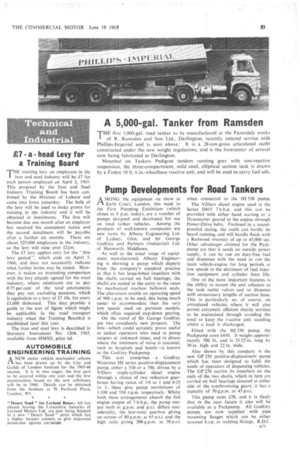Pump Developments for Road Tankers
Page 55

If you've noticed an error in this article please click here to report it so we can fix it.
MONG the equipment on show at in. Earls Court, London. this week in the First Pumping Exhibition (which closes at 9 p.m. today), are a number of Pumps designed and developed for use on road tanker vehicles. Among the products of well-known companies are new items by Albany Engineering Ltd. of Lydney. Glos; and •Sir George Godfrey and Partners (Industrial) Ltd. of Hanworth, Middlesex.
As well as the usual range of equipment manufactured. Albany Engineering is shciwing a pump which departs from the company's standard practice in that it has large-lobed impellers with the shafts carried on ball bearings; the shafts are sealed at the entry to the cases by mechanical (carbon bellows) seals. The alterations enable an operating speed of 960 r.p.m. to be used, this being much easier to accommodate than the very low speeds used on previous models. which often required step-down gearing.
• On the stand of Sir George Godfrey are two completely new projects. The first—which could certainly prove useful to tanker operators who need to pump cargoes at awkward times, and in places where the minimum of noise is essential, such as hospitals and hotels—is known as the Godfrey Packpump.
This unit comprises a Godfrey Waterous Hi series positive-displacement pump, either a 530 or a 700, driven by a Villiers single-cylinder diesel engine through a choice of two reduction gearboxes having ratios of 3.0 to 1 and 6.25 to 1; these give pump revolutions of 1,100 and 550 r.p.m. respectively. Whilst both these arrangements absorb the full engine output of .7 b.h.p., the pump output both in g.p.m. and p.s.i. differs considerably, the low-ratio gearbox giving an output of 80 g.p.m. at 65 p.s.i. and the high ratio giving 200 g.p.m. at 30 p.s.i.
when connected to the HI 530 pump.
The Villiers diesel engine used is the Series D415 7 b.h.p. and this can be provided with either hand starting or a Dynostarter geared to the engine through Power-Drive belts. Enclosed in a soundproofed casing, the outfit can hardly be heard running, and will handle fluids with a Redwood viscosity of un to 45,000 sec. Other advantages claimed for the Packpump are that it needs no outside power supply, it can he run on duty-free fuel and dispenses with the need to run the Main vehicle-engine for long periods at low speeds to the detriment of fuel injection equipment and cylinder bore life.
One of the most important features is the ability to mount the unit adjacent to the tank outlet valves and so dispense with unnecessary lengths of. suction hose. This is particularly so, of course, on • articulated vehicles where it will also permit extremely efficient shuttle services to be maintained through avoiding the need to keep the tractive unit standing whilst a load is discharged.
Fitted with the H1 530 pump, the Packpump costs £410. it weighs approximately 500 lb. and is 51-25 in. long by 30 in. high and 22 in. wide.
Also shown by this company is the new GP 250 positive-displacement pump which has been designed to fulfil the needs of operators of dispensing vehicles.. The GP 250 carries its impellers on the ends of the two shafts, which in turn are carried on ball hearings situated at either side of the synchronizing gears., it has a capacity of 50 g.p.m. at 45 p.s.i.
This pump costs £78, and it is likely that in the near future it also will be available as a Packpump. All Godfrey pumps • are now supplied with pipe mounting flanges which can be either screwed b.s.p. or welding fittings. R.D.C.




































































































































